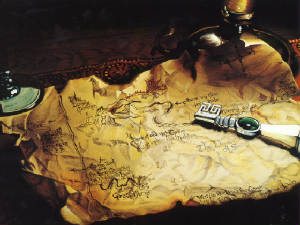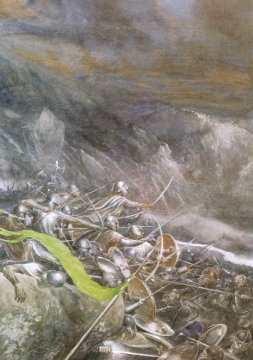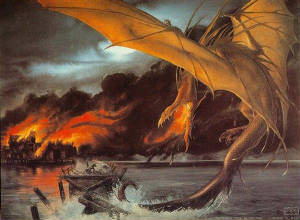
| Home | Biography: J.R.R. Tolkien | 'The HOBBIT!' | Hobbit: EVENTS | 'The LORD OF THE RINGS' | 'The GALLERY' | Related Links | ||||||||||||||||||||||||
|
J.R.R. Tolkien |
||||||||||||||||||||||||
|
Hobbit: EVENTS
|
||||||||||||||||||||||||
|
Thrórs Map The map that guided the Quest of Erebor A map made by Thrór the King under the Mountain, after he had been exiled from his kingdom by the Dragon Smaug. As was traditional among the Dwarves, it was drawn with East at the top of the map, rather than North, and showed the Lonely Mountain of Erebor, the Running River that flowed from it, and the lands about. It also contained mention of a secret entrance to the Mountain, and (written in secret Moon-letters) instructions as to how it might be opened. In his old age, Thrór set out to wander the lands of Middle-earth, but before departing he gave the heirlooms of his house to his son Thráin, including his Map. Years later, Thráin too set out into Middle-earth, seeking to recover Erebor himself, and taking with him the Map to guide his way. He was captured in the Wild by the servants of Sauron, but Sauron captured Thráin for the Ring of Power he bore, and so overlooked the Map he carried too. This proved to be a serious oversight, because Gandalf secretly entered Sauron's lair at Dol Guldur while Thráin was a prisoner there, and managed to escape with the Map and the key that opened the secret door.
Using Thrór's Map, his grandson Thorin was able to lead a small group of Dwarves (and one Hobbit, a certain Bilbo Baggins) on his own quest to refound the ancient Dwarf-realm. Through many adventures, they were able to recover Erebor and bring about the destruction of Smaug, dealing Sauron a serious reverse.
"So began a battle that none had expected; Since the ending of the War of the Dwarves and Orcs, and the Dwarves' ultimate victory at the Battle of Nanduhirion, the orcs had nursed a hatred of that race. In the year III 2941, the year of Bilbo Baggin's journey to the Lonely Mountain, those events lay more than one hundred and forty years in the past. Travelling through the Misty Mountains, Bilbo, Thorin and their companions were captured by a colony of the orcs that infested those regions. With Gandalf's help they escaped, but not before killing several of their captors, including their leader the Great Goblin.
The loss of the Great Goblin at the hands of a band of Dwarves inflamed the bitter memories of the orcs' War with the Dwarves. Under the command of Bolg, whose own father Azog had been killed at Nanduhirion, all the armies of the orcs of the Misty Mountains, and their allies the wolves and bats, began to gather and plan their revenge.
Oblivious to these events, Bilbo and the Dwarves continued their journey eastward. They achieved their quest to recover Erebor, but in doing so they earned the anger of Thranduil, and indirectly caused the destruction of Lake-town. Thranduil's Wood-elves joined with the Lake-men, and they marched north to claim a share of Smaug's treasure in recompense. In response, Thorin called on his cousin Dáin, who set out with his own army from the Iron Hills.
So the scene was set for a confrontation between the Wood-elves and Lake-men on the one side, and the Dwarves of Thorin and Dáin on the other. Already the first arrows had been shot when a dark cloud was seen coming out of the north - the bats that heralded the orc-armies of Bolg. The Elves, Men and Dwarves quickly forgot their differences in the face of this new threat, and battle was joined on the slopes of Erebor and the valley beneath. The battle was ferocious, and as it raged, it was joined by others - Eagles out of the Misty Mountains, and even Beorn himself in the shape of a monstrous bear.
By nightfall the orcs were defeated, but not without great loss. Thorin himself was slain, making a bold attack against the bodyguard of Bolg, and with him fell his young nephews Fíli and Kíli. Bolg was dead, too, crushed by Beorn, and the goblins of the northern mountains were scattered or destroyed.
Smaug was the last of the great fire-drakes, and said to be the greatest dragon of his time. At some time during the twenty-eighth century of the Third Age, he came to hear of the immense wealth held by the Dwarves of Erebor. Where he came from we do not know for certain, but in the year III 2770 he descended in fire on the Lonely Mountain, destroying the Dwarf-kingdom and the nearby township of Dale.
Gathering together the treasures of the Dwarves, he formed himself an immense bed of gold and jewels and settled within the ruined halls of Erebor. Slowly the years and decades passed, until the people of the Long Lake to the south had almost forgotten the Dragon of Erebor and Smaug imagined himself unassailable.
Then, one day in the October of III 2941, one hundred and seventy-one years after his arrival in Erebor, Smaug awoke to find his treasure disturbed. Of all that mountain of wealth, he noticed with rage that a single two-handled
cup had been taken. He could not have imagined that the loss of that cup signalled his own imminent downfall; Thorin, the heir of the King under the Mountain that Smaug had driven from his halls those many years before, had returned to reclaim his kingdom. With him came Bilbo Baggins, a hobbit with a magical Ring with which he had invisibly removed that single cup from Smaug's treasure.
In his anger, the dragon flew from his halls, scorching and breaking the mountainside. Thorin, Bilbo and their companions were sealed in a hidden tunnel, and at last the frustrated Smaug gave up his attack on the mountain.
Realizing that they must have had help from Lake-town to the south, he set out to punish the Men of the Lake instead.
That was to be Smaug's last flight. Bilbo had managed to discover an open patch in the dragon's armour, and word of this had been carried to Lake-town. In particular, it reached the heir of another of Smaug's victims, Bard, the descendant of Girion of Dale. Bard shot Smaug with an arrow, and though Lake-town was devastated in his attack and fall, the dragon was defeated. In years to come, beneath the waters of the lake his mighty bones could be seen, and the jewels that had lined
his hide: the last remains of the greatest dragon of his age.
|
||||||||||||||||||||||||
|
|
||||||||||||||||||||||||
|
|
||||||||||||||||||||||||


